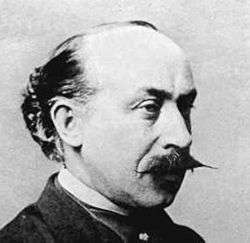Béla Kéler

Béla Kéler, (Hungarian: Kéler Béla), also known as Adalbert Kéler and Adalbert Paul von Kéler,[1] born as Albert Paul Keler on 13 February 1820 in Bártfa, (since 1920 Bardejov), Sáros County, Kingdom of Hungary, died 20 November 1882 in Wiesbaden), was a Hungarian composer and conductor of Slovak origin.
Biography
After dropping out of law school,[2] he worked on a farm where he read a textbook by Johann Georg Albrechtsberger and started practicing the violin. By the time he moved to Vienna, he was good enough to play in the orchestra of the Theater an der Wien. While holding this position, he studied with Simon Sechter. He became leader of the Gungl Band in Berlin in 1854, and the next year succeeded Augustin Lanner in Vienna. From 1856 to 1863 he was Kapellmeister of an infantry regiment in the Vienna garrison.[3] In 1867, he joined the Kur Orchestra in Wiesbaden, where he remained until 1873.[3][4] In the 1870s, Kéler toured all over Europe.
Born in 1820 in Bardejov (Slovakia), as Albert Paul. Father Stefan (1781-1849) was a Principal magistrate of the town of Bardejov (at that time, part of Austria-Hungary), mother Anna Both (1793-1848) raised 13 children. Siblings: Frederika, Stefan, Emilia, Antonia, Matilda, Augusta, Apolonia, Ferdinand, Viktor, Jozefina, Amalia. As a little boy he studied violin (F. Schiffer in Bardejov). The household was German. Education: in 1834 lyceum (in German language) in Levoca, then Evangelical collegium in Presov, later short studies in Debrecin: law, philosophy and also Hungarian language. Soon he left and studied again in Presov. Living and working in Presov, leading a Students orchestra there. Since 1845, he lived in Vienna (Theater an der Wien) and from 1863 in Wiesbaden (Germany), where is also his grave. His testament: all his work, autography etc. he gave to the town of Bardejov (Slovakia), Museum of Bardejov. (Source: http://www.muzeumbardejov.sk/keler/en/index.html.)
Compositions
He was very popular as a composer of orchestral and dance music, and was looked upon as one of the best of writers of violin solos.[4] His overtures and compositions for small orchestra were long popular in the United States and England.[3]
Johannes Brahms based one of his Hungarian Dances on a csárdás by Kéler[5] (he mistakenly thought it was a genuine Hungarian folk melody), while Anton Bruckner copied the instrumentation and form (but not the harmony) of Kéler's Apollo-Marsch (also called Mazzuchelli-Marsch) exactly for his own March in E-flat major.[6] (The Apollo Marsch was later mistaken for a work of Bruckner's).
References
- ↑ "Kéler Béla" by Andrew Lamb in New Grove ed. Stanley Sadie, (2001) vol. 13 p. 458
- ↑ p. 458 Lamb (2001) Andrew
- 1 2 3
 Gilman, D. C.; Thurston, H. T.; Colby, F. M., eds. (1905). "Kéler-Béla". New International Encyclopedia (1st ed.). New York: Dodd, Mead.
Gilman, D. C.; Thurston, H. T.; Colby, F. M., eds. (1905). "Kéler-Béla". New International Encyclopedia (1st ed.). New York: Dodd, Mead. - 1 2
 Rines, George Edwin, ed. (1920). "Kéler-Béla, Albert Von". Encyclopedia Americana.
Rines, George Edwin, ed. (1920). "Kéler-Béla, Albert Von". Encyclopedia Americana. - ↑ "Kéler Béla" by Andrew Lamb in New Grove ed. Stanley Sadie, (2001) vol. 13 p. 458
- ↑ Preface to Band XII/8 of the Complete Works of Anton Bruckner by Rüdiger Bornhöft translated by Eugene Hartzell (1996) Vienna: Musikwissenschaflticher Verlag, unnumbered right page before score. The tome has the score of the Bruckner's March in E-flat, with the Apollo-Marsch, as an "appendix."
External links
- Works by or about Béla Kéler at Internet Archive
- Free scores by Béla Kéler at the International Music Score Library Project
- Page about Béla Kéler